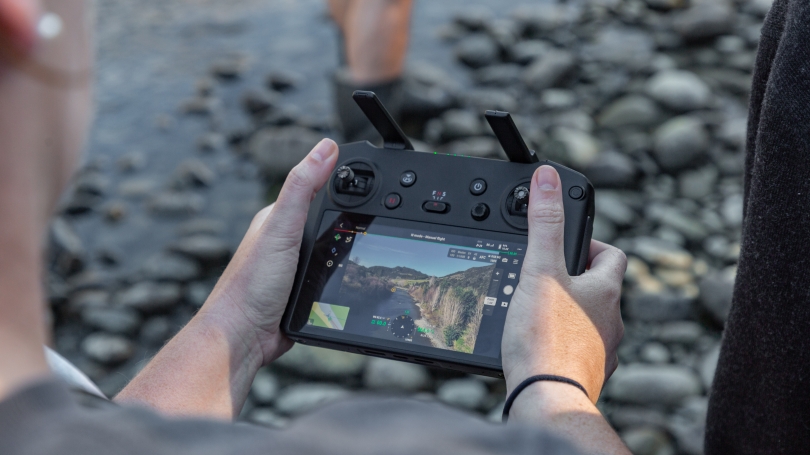
- About
- Advising
- Community & Leadership
- Education
- Advocacy
- News
Back to Top Nav
Back to Top Nav
Back to Top Nav
Back to Top Nav
Back to Top Nav
Between the Spring and Summer terms of 2024, I, Chase Kamikawa '26 along with Mahina Damon '26, spent three weeks in Aotearoa (New Zealand) as research assistants to Lecturing Professor in the Native American and Indigenous Studies department, Meredith "Brinker" Ferguson. Spending time in both Whanganui and Cape Regina/Te Rerenga Wairua regions, the team collaborated with several Indigenous-led research centers and Māori communities to collect and interpret multispectral imaging data to be used for Indigenous-led eco-cultural regeneration of several sacred sites.
Our team began working together in Fall 2023, where we learned how to collect multispectral imaging data via drone on different sites near campus. The drone we used collected Near Infared, Red, Green, and Red Edge wavelengths of light data, which we then used to later analyze vegetation health, erosion information, and even map different types of plants and trees. In Winter and Spring of 2024, our team then worked with Steve Gaughan in Research Computing, where we learned how to process this information for analysis in ArcGIS.
Our research trip began soon after classes ended in June and spanned three weeks in Aotearoa. The team spent time in two remote areas, Whanganui and Cape Reinga/ Te Rerenga Wairua, collaborating with Māori tribes in the area to address their concerns they have related to their sacred environments. In completing work according to the Māori moon calendar, our team was able to simultaneously learn about traditional cultural customs while staying on the marae (traditional meeting house).
I have to say that this research trip was such a life-changing experience, both to stay in the marae and immerse ourselves in the culture of the Māori. As a Native Hawaiian, it was incredible to witness the similarities between our two cultures, yet continuing to recognize the subtle differences, too.
Once we arrived, our first site was Moutoa Island, which lies within the Whanganui River. The Whanganui River is the first body of water to be granted legal personhood, as recognized by New Zealand law in 2017. This distinction has far-reaching implications for the welfare of the Māori communities that trace their genealogies back to this river and the life-giving properties it possesses. The research team spent three days with a Whanganui hapu (tribe from Whanganui) at their marae witnessing and engaging with the traditional cultural practices. The team collaborated with an Indigenous-centered Research Institute, Te Atawhai o Te Ao, to educate young Māori scholars from the marae on these types of imaging technologies so that they can use it for their future eco-cultural monitoring.
These young scholars, ranging in ages from four to eleven years old, learned about multispectral data collection and the importance of combining this with mātauranga (traditional Māori knowledge systems) as future stewards of their lands. The team noted how important it was to plant the seeds of this knowledge at a young age, ensuring that these practices for ecocultural monitoring and regeneration occurs for generations to come.
The second part of the project was focused on working with the Indigenous-led Te Ara Whanui Research Center in Cape Reinga/ Te Rerenga Wairua. Located at the northern most point of Te Ika-a-Māui (North Island of New Zealand), lies the ancestral home of Ngati Kuri, an Indigenous Māori tribe. Mahina Damon recalls, "Over the course of three days, the research team used multispectral imaging powered by a drone to collect data at Te Reinga Wairua and the burn site, Te Werahi. After the data collection, the team worked with members of Ngati Kuri on exploring methods of processing the data through mātauranga." Damon adds, "I had the opportunity to grow my appreciation for another Indigenous cultural system. The scholars that I worked with are what made the experience unique and memorable."
This entire research opportunity left an indelible mark, not only with my time here at Dartmouth, but will be an experience I carry for the rest of my life. This research opportunity has allowed me to build upon my interests, blending environmental and Native Hawaiian rights, demonstrating the possibilities for integrating modern technologies and traditional knowledge systems for future research. As an Indigenous student at Dartmouth, I am so lucky to have had this opportunity to connect with other Pasifika peoples through this amazing research opportunity, building and fortifying connections that have been going strong for over a thousand years. It is with utmost gratitude to the Native American/Indigenous Studies department at Dartmouth who made this opportunity possible.
In the future, Damon likewise hopes to bring her newfound experiences and knowledge about global Indigenous issues back to Dartmouth to create her own way to address Native Hawaiian issues. She is "interested in furthering investigations into how people of different Indigenous backgrounds find themselves addressing the same issues amongst their communities regarding land rights, environmental devastation and language practices." Damon would like to thank the Native American and Indigenous Studies Department, Department Chair Bruce Duthu, and Professor Brinker Ferguson for their support during this entire research process.